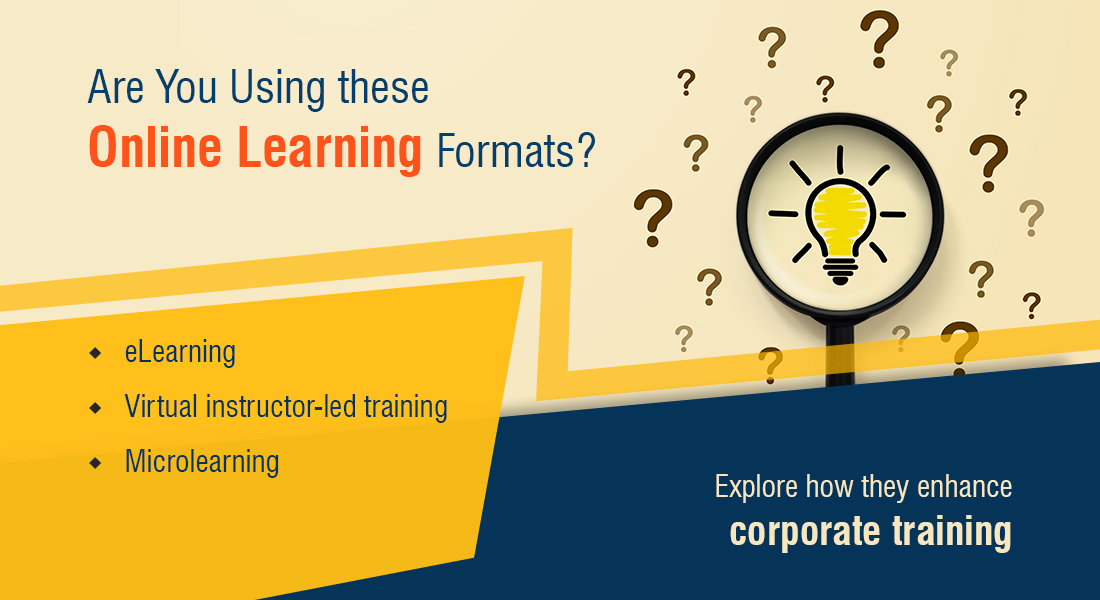Top Online Learning Formats & Techniques to Boost Corporate Training

In today's fast-paced corporate environment, effective training is crucial for employee development and organizational success. With the rise of digital learning, companies are increasingly turning to online platforms to deliver training. However, not all online learning formats are created equal. In this blog, we will explore the most popular online learning formats, the interactive and immersive methods that boost training efficiency, and the video formats that make learning engaging. By understanding and leveraging these formats, you can transform your corporate training programs into powerful, engaging, and effective learning experiences.
→ Download Now: Instructional Design Strategies to Design Engaging eLearning Courses
Table of Contents
- What Are the 4 Popular Online Learning Formats?
- What Are the Top Interactive Learning Formats That Boost Corporate Training Efficiency?
- What Are the Popular Video Formats Used in eLearning?
- What Are the Top 3 Immersive Learning Formats?
What Are the 4 Popular Online Learning Formats?
What Are the Four Effective Online Learning Formats for Corporate Training?
Here’s the list:
- eLearning
- Microlearning
- VILT
- Social Learning
To start, let's look at the foundational formats that set the stage for online learning.
1. Evergreen ‘eLearning’
eLearning, contrary to popular misconceptions isn’t publishing a well-designed classroom PowerPoint deck with an eLearning authoring tool, nor is it digital job-aids. eLearning is learning facilitated by technology – for its design, development, deployment, and delivery.
And eLearning can be very easy to start as it can leverage existing classroom training material. Effective eLearning courses make learners active participants and not just screen gazers. They are based on instructional design strategies and adult learning principles and leverage eLearning authoring tools.
With eLearning, you can develop courses once and use them in multiple ways for different learner groups. Rapid eLearning is a faster, leaner form of custom eLearning that helps organizations roll out training with scale, speed, and quality.
Some characteristics of eLearning:
- Based on performance-based learning objectives that cascade from organizational goals
- Needs the involvement of subject matter experts (SMEs) and facilitators
- Can be designed as standalone courses or a curriculum of modules (on each topic)
Watch this video to learn how Generative AI can enhance your eLearning design.
2. Maximal ‘Microlearning’
Microlearning is short eLearning courses – each covering one learning objective comprehensively. With microlearning, relevant and concise learning modules can be delivered to learners – for learning or for performance support.
Microlearning is a logical response to today’s fast-paced society and learners driven toward short learning bytes accessible easily. Since microlearning modules are short, focused, and mobile-compatible, it is an effective way to ensure your employees have access to learning whenever needed. They can look up what they need without having to sift through bulky books or lengthy eLearning courses.
And microlearning isn’t just limited to videos or performance support. Microlearning modules can be used:
- As standalone training courses
- To offer reinforcement and practice opportunities
- As components in a blended learning program
The interesting aspect is that microlearning courses can be designed in several formats which ensures form follows function. Here’s an infographic listing the 10 best examples of microlearning formats.
.png?width=1920&height=1080&name=10%20Best%20Examples%20of%20Microlearning%20Assets%20(1).png)
3. Vibrant ‘VILT’
Virtual Instructor-led Training (VILT) is a training approach where the learner and instructor meet at the same time – online through videoconferencing software – though situated in different locations, in a virtual replica of brick-and-mortar classrooms.
If you think a webinar might well take the place of VILT – here’s some food for thought. A webinar is a one-way communication with the presenter doing much of the talking. Participants get to share their opinions, and feedback, or answer questions through polls – which doesn’t leave much room for collaboration. The main essence of virtual classrooms – collaboration – is missing in webinars.
Virtual classrooms give participants the opportunity to participate and collaborate actively, engage in group activities, and share their learning.
Here’s a comprehensive list of popular collaboration activities that can be used in a VILT session:
- Chats for textual communication
- Polls to collect opinions, stimulate recall, or quiz learners
- ‘Raise hand’ option to ask questions or bring something to the notice of the instructor
- Annotations to help learners type an answer or pick favorites from a pool of alternatives
- Breakout rooms or virtual rooms where small groups of learners can meet to discuss, share opinions, and participate in group activities. Results and findings from discussions in breakout rooms can be shared in the main session.

Instructional Design Strategies to Design Engaging eLearning Courses
Design Learner-Centric eLearning
- Importance of ID Strategies in eLearning
- Parameters to Select the Right ID Strategy
- ID Strategies for Effective Results
- Case Studies
4. Super ‘Social Learning’
Social learning creates a collaborative environment for employees and encourages teamwork. Many organizations are now turning to social media to provide human interaction. It enables employees to collaborate and communicate without any boundaries – with peers and instructors.
Employees can share tips, tricks, and advice with their co-workers – and these can be moderated if needed. Employees can be kept posted about the latest happenings and company news. A learning management system (LMS) can be used to set up chat rooms and discussion forums on various topics or for different teams/functions.
Here are some ideas to use social learning effectively:
- Create groups on social media platforms such as LinkedIn or Facebook for learners to connect and network.
- Post announcements about upcoming courses, including easy-access links to videos on YouTube.
- Use the “story” feature of platforms such as Instagram, Snapchat, and Facebook to highlight the benefits of the course, key takeaways, etc.
- Post blogs that quickly brush up on information your learners must be acquainted with.
- Have learners participate in assignments on social media platforms. For instance, ask them to create a story using Twittories or chain through their tweets.
- Post microlearning resources such as videos, interactive PDFs, and infographics on your social media platforms.

What Are the Top Interactive Learning Formats That Boost Corporate Training Efficiency?
1. Gamification
Gamification enhances learning by incorporating game elements into non-game contexts, such as corporate training. It offers several advantages:
1. Increased Engagement: Games are inherently enjoyable, boosting motivation and active participation.
2. Healthy Competition: Leaderboards and rewards foster friendly competition, motivating employees to excel.
3. Personalized Learning: Game mechanics tailor content to individual needs and skill levels, improving the relevance of training.
4. Promoting Problem-Solving Skills: Games encourage critical thinking and strategic skills, valuable in a professional setting.
Gamification transforms training into an engaging and effective learning experience, benefiting both employees and organizations.
2. Simulation
Simulation is a highly effective learning format gaining traction in corporate training. It provides hands-on practice in realistic scenarios, boosting confidence and understanding while allowing for mistakes without consequences. Tailored to specific job roles, simulations engage learners actively and bridge the gap between theory and practical application. They offer an immersive experience that develops problem-solving skills and ensures immediate knowledge application in the workplace.
3. Role-playing
Role-playing, a well-established interactive learning method in corporate training, immerses participants in real-life scenarios. This approach hones essential skills like critical thinking, problem-solving, and effective communication. Role-playing also nurtures empathy, fosters understanding of diverse perspectives, and creates a safe space for learning through mistake-friendly environments. Moreover, it offers personalized learning experiences tailored to specific challenges, promoting teamwork, collaboration, and creativity.
4. Group Activities
Group activities are an essential component of any successful corporate training program. They offer a unique opportunity for individuals to come together and learn from one another while also fostering teamwork, communication, and problem-solving skills. Some group activities for corporate training include team building challenges, and group discussions.
5. Case Studies
Case studies are a valuable tool for corporate training programs as they provide real-life examples and scenarios for employees to analyze and learn from. By using case studies, trainers can create interactive learning experiences that engage employees and help them apply their skills and knowledge in practical situations.
6. Virtual Reality/Augmented Reality
Virtual Reality (VR) and Augmented Reality (AR) are increasingly popular in corporate training, offering immersive learning experiences. VR creates virtual environments with interactive headsets, while AR overlays computer-generated data on the real world.
The key benefits of VR/AR in corporate training include:
1. Simulating Complex Scenarios: VR replicates complex or hazardous situations, enabling safe practice for emergency responses or machinery operation.
2. Customized Learning: These technologies provide customizable training, tailoring difficulty levels, feedback, and progress tracking to individual needs for effective learning.

Instructional Design Strategies to Design Engaging eLearning Courses
Design Learner-Centric eLearning
- Importance of ID Strategies in eLearning
- Parameters to Select the Right ID Strategy
- ID Strategies for Effective Results
- Case Studies
7. Microlearning
Microlearning, a recent trend in corporate training, delivers short, easily digestible content to learners. It breaks complex topics into manageable chunks, improving comprehension and retention.
Key benefits of microlearning include:
1. Flexibility: Learners can engage at their own pace, fitting learning into busy schedules without feeling overwhelmed.
2. Interactivity: Multimedia elements like videos, animations, quizzes, and games engage learners, reinforce concepts, and provide instant feedback.
3. Learning Styles: Microlearning accommodates visual, auditory, and hands-on learners with various formats, ensuring effective knowledge retention.
4. Cost-Effective: Focused, shorter modules save organizations costs compared to traditional training methods.
Microlearning is a versatile and cost-effective approach, enhancing the learning experience for employees.

Instructional Design Strategies to Design Engaging eLearning Courses
Design Learner-Centric eLearning
- Importance of ID Strategies in eLearning
- Parameters to Select the Right ID Strategy
- ID Strategies for Effective Results
- Case Studies
What Are the Popular Video Formats Used in eLearning?
Video has become an indispensable tool in online learning, offering a dynamic way to present information that appeals to both visual and auditory learners. By incorporating various video formats into your corporate training program, you can enhance understanding, increase engagement, and cater to different learning styles.
1. Explainer Videos
Explainer videos are a popular format that breaks down complex topics into easily digestible segments. These short, focused videos use clear visuals and concise narration to explain concepts, making them ideal for introducing new ideas or processes. Explainer videos are particularly effective in providing a high-level overview and ensuring that employees grasp the essential points quickly.
2. Screencasts
Screencasts capture the activity on a computer screen and are excellent for demonstrating software applications, procedures, or workflows. They are often used to provide step-by-step instructions or tutorials, allowing learners to follow along with real-time examples. Screencasts are valuable for training on new tools or systems, as they offer a practical, hands-on approach to learning.
3. Interactive Videos
Interactive videos take engagement a step further by incorporating interactive elements such as quizzes, clickable links, or decision points within the video. This format allows learners to actively participate and apply their knowledge as they progress through the content. Interactive videos are particularly effective for reinforcing learning and assessing comprehension in a more engaging and personalized manner.
Integrating these video formats into your training program not only makes learning more accessible but also keeps employees motivated and involved. By leveraging the strengths of each video type, you can create a varied and compelling learning experience that addresses different preferences and needs, ultimately enhancing the overall effectiveness of your corporate training.
What Are the Top 3 Immersive Learning Formats?
1. Augmented Reality
When you mix the real world with digital content to create a specific environment, it’s called augmented reality. In simple words, you stay where you are, but certain computerized assets can be added to your surroundings, and you will be able to digitally interact with them in real time. These assets can either be 3d or 2d depending on the requirements and the nature of the asset you are trying to embed. The best example can be Snapchat filters like you are just facing your camera, but certain virtual assets can be triggered either by your actions or just by your existence.
Augmented reality can help with training sessions such as safety training or machinery training. The audio-visual interactivity helps the learners to properly gain an immersive learning experience and retain most of the knowledge they gain. For example, consider a bunch of employees in the non-IT department can be provided with an AR program where they can operate certain programs, make mistakes, and learn from it, so when they get to use the actual device, they can confidently proceed further with the task and not commit fatal errors.
2. Virtual Reality
Unlike augmented reality, everything whether real or hypothetical, goes virtual here. Learners are provided with a VR headset to get immersed in the virtual world of simulations that replicate real-world scenarios. VR can be programmed to enable first-hand interactions with almost everything in the virtual environment, making it highly engaging and exciting to discover new possibilities. Virtual reality has use cases similar to AR, but unique uses exist as well. To provide a better VR experience, it is often merged with AR to provide the maximum benefits to the learner and motivate them to do better. Authoring tools like CenarioVR makes the development of VR-based eLearning courses easier and more creative.
3. Scenarios and Simulations
Getting back to basics, before AR and VR digitalized the concept of immersive learning, their core was established by the concept of learning through scenarios and simulations. Scenario-based learning, as the name suggests, makes the user understand different concepts and develop their skills with the help of work-related scenarios. These scenarios can either be vocally explained or visually, depending on the type of training. Learners are given a real-life scenario where their actions determine the result of the course and thereby develop their critical thinking and decision-making skills. This helps organizations to understand their employees in a more personalized manner and design their courses accordingly. Ex. sales training, customer support, and leadership training.
Simulations, on the other hand, have a more practical approach to immersive learning. Learners are provided a sandbox environment where they can execute real-world tasks and practices, and learn from their mistakes risk-free until they are ready for the real task. eLearning simulations are developed mostly for the manufacturing industries that use heavy machinery and multiple technologies so that their real equipment doesn’t get damaged while learners are getting trained for their usage. But, since learning has become more innovative, simulations are getting used for other departments as well. Ex. product training, skill training, and software training.
Wrapping Up
In today's fast-paced corporate world, effective training is crucial for success. This blog has highlighted key online learning formats, interactive methods, and video styles to enhance your training programs. By integrating diverse formats such as explainer videos, screencasts, and immersive technologies like AR and VR, you can create engaging and impactful learning experiences. Tailoring these methods to your organization's needs will boost efficiency, motivate employees, and drive success. For more tips on designing engaging eLearning, download our guide on Instructional Design Strategies.
Ready to elevate your corporate training? Download our eBook “Instructional Design Strategies to Design Engaging eLearning Courses” and discover practical tips for creating impactful and engaging training programs.
Editor’s note: This post was originally published on July 17, 2024 and has been updated for comprehensiveness.






